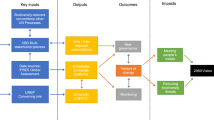Abstract
To address the invasion of non-native Phragmites in the Great Lakes, researchers at the U.S. Geological Survey—Great Lakes Science Center partnered with the Great Lakes Commission in 2012 to establish the Great Lakes Phragmites Collaborative (GLPC). The GLPC is a regional-scale partnership established to improve collaboration among stakeholders and increase the effectiveness of non-native Phragmites management and research. Rather than forming a traditional partnership with a narrowly defined goal, the GLPC follows the principles of collective impact to engage stakeholders, guide progress, and align resources to address this complex, regional challenge. In this paper, the concept and tenets of collective impact are described, the GLPC is offered as a model for other natural resource-focused collective impact efforts, and steps for establishing collaboratives are presented. Capitalizing on the interactive collective impact approach, the GLPC is moving toward a broadly accepted common agenda around which agencies and individuals will be able to better align their actions and generate measureable progress in the regional campaign to protect healthy, diverse ecosystems from damage caused by non-native Phragmites.
Similar content being viewed by others
References
Bourgeau-Chavez L, Kowalski KP, Carlson Mazur ML, Scarbrough KA, Powell RB, Brooks CN et al (2013) Mapping invasive Phragmites australis in the coastal Great Lakes with ALOS PALSAR satellite imagery for decision support. J Gt Lakes Res 39:65–77
Cabaj M (2014) Evaluating collective impact: five simple rules. The Philanthropist 26(1):109–124
Edmondson J (2013) The impact continuum: recognizing the value of collaboration and collective impact. Striving for change. http://www.strivetogether.org/blog/2013/10/the-impact-continuum-recognizing-the-value-of-collaboration-and-collective-impact/. Accessed 8 Oct 2015
Edmondson J, Hecht B (2014) Defining quality collective impact. Stanf Soc Innovation Rev. http://ssir.org/articles/entry/defining_quality_collective_impact. Accessed 8 Oct 2015
Gannon JJ, Moore CT, Shaffer TL, Flanders-Wanner B (2012) An adaptive approach to invasive plant management on U.S. Fish and Wildlife Service-owned native prairies in the Prairie Pothole Region: decision support under uncertainty. In: Williams D, Butler B, Smith DD (eds) Proceedings of the twenty-second North American prairie conference. University of Northern Iowa, Cedar Falls, Iowa, pp 136–145
Great Lakes Interagency Task Force (2014) Great Lakes Restoration initiative action plan II. Great Lakes Restoration http://www.greatlakesrestoration.us/actionplan/pdfs/glri-action-plan-2.pdf. Accessed 8 Oct 2015
Great Lakes Phragmites Collaborative (2015) Phragmites treatment herbicide quick guide. http://greatlakesphragmites.net/files/HerbicideQuickGuide.pdf. Accessed 25 Mar 2016
Hanleybrown F, Kania J, Kramer M (2012) Channeling change: making collective impact work. Stanf Soc Innov Rev. http://ssir.org/articles/entry/channeling_change_making_collective_impact_work. Accessed 8 Oct 2015
Harvey R, Mazzotti F (2014) The invasion curve: a tool for understanding invasive species management in south Florida. University of Florida Institute of Food and Agricultural Sciences. https://edis.ifas.ufl.edu/pdffiles/UW/UW39200.pdf. Accessed 25 Mar 2016
Hull B, Robertson D (2015) Why is collective impact important for the Chesapeake Bay? Virginia Polytechnic Institute and State University, College of Natural Resources and Environment. http://cligs.vt.edu/collective-impact/. Accessed 8 Oct 2015
Kania J, Kramer M (2011) Collective impact. Stanf Soc Innov Rev 9(1):36–41
Kania J, Kramer M (2013) Embracing emergence: how collective impact addresses complexity. Stanf Soc Innov Rev. http://ssir.org/articles/entry/embracing_emergence_how_collective_impact_addresses_complexity. Accessed 8 Oct 2015
Kowalski KP et al (2015) Advancing the science of microbial symbiosis to support invasive species management: a cause study on Phragmites in the Great Lakes. Front Microbiol 6:95. doi:10.3389/fmicb.2015.00095
Levin S (1992) The problem of pattern and scale in ecology. Ecology 73(6):1943–1967
Moore CT, Shaffer TL, Gannon JJ (2013) Spatial education: improving conservation delivery through space-structured decision making. J Fish Wildl Manag 4(1):199–210
Nagurka P, Orr J, Picat I, Smith J, Thompson-Deahl C (2013) Collective impact for environmental conservation. Glob impact. https://scholar.vt.edu/access/content/user/hullrb/XMNRPapers2013/JamesaAndLearningBarge.pdf. Accessed 8 Oct 2015
Reid R (2014) The Canadian boreal forest agreement: unlikely allies pursuing conservation and sustainable development in Canada’s boreal regions. The Philanthropist 26(1):65–73
Turner S, Merchant K, Kania J, Martin E (2012) Understanding the value of backbone organizations in collective impact. Stanf Soc Innovation Rev. http://www.fsg.org/publications/understanding-value-backbone-organizations-collective-impact. Accessed 8 Oct 2015
Walters C, Holling C (1990) Large-scale management experiments and learning by doing. Ecology 71:2060–2068
Weaver L (2014) The promise and peril of collective impact. The Philanthropist 26(1):11–19
Wiley P, Bierly K, Reeve T, Smith K (2013) When local solutions aren’t enough: a strategic funding partnership to restore a large river system. Found Rev 5(1):100
Williams B, Brown E (2012) Adaptive management: the U.S. Department of the Interior applications guide. Adaptive Management Working Group, U.S. Department of the Interior, Washington, DC
Wondolleck J, Yaffee S (2000) Making collaboration work: lessons from innovation in natural resource management. Island Press, Washington, DC
Acknowledgments
Financial support from the Great Lakes Restoration Initiative through the U.S. Environmental Protection Agency’s Great Lakes National Program Office allowed the team from the U.S. Geological Survey (USGS)—Great Lakes Science Center and the Great Lakes Commission (GLC) to complete this project. We are grateful to Wes Bickford (USGS), Kim Bourke (IAP Contractor), and Sarah Cook (GLC) for contributions to the development of this collaborative and to Michèle Leduc-Lapierre (GLC) for her assistance to the collaborative and early writing contributions to this manuscript. Finally, we are grateful to the known and anonymous reviewers for their constructive comments. Any use of trade, product, or firm names is for descriptive purposes only and does not imply endorsement by the U.S. Government. This is contribution 2030 of the USGS Great Lakes Science Center.
Author information
Authors and Affiliations
Corresponding author
Additional information
Guest editors: Laura A. Meyerson and Kristin Saltonstall/Phragmites invasion.
Rights and permissions
About this article
Cite this article
Braun, H.A., Kowalski, K.P. & Hollins, K. Applying the collective impact approach to address non-native species: a case study of the Great Lakes Phragmites Collaborative. Biol Invasions 18, 2729–2738 (2016). https://doi.org/10.1007/s10530-016-1142-1
Received:
Accepted:
Published:
Issue Date:
DOI: https://doi.org/10.1007/s10530-016-1142-1




